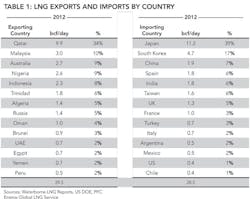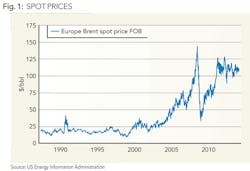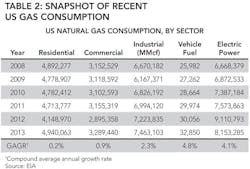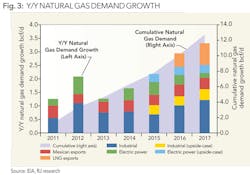Natural gas export applications soaring
Represents 51% of total current domestic production
John White, Houston
US Approves Expanded Gas Exports – Wall Street Journal
US Freeport, Cameron LNG Export Rulings Seen in Coming Months – Bloomberg
Exclusive: World Buyers Line Up to Buy US Natural Gas – Reuters
Do headlines like these look familiar? If you are in the oil and gas business, they should because it seems like we see them practically every day. Due to an abundant supply of US-produced natural gas, there has been a huge move by the industry to file for approval from the US government for legal export. A company seeking to export liquefied natural gas (LNG) must first submit an application to the US Department of Energy, or DOE.
A list of the applications can be found here: http://energy.gov/sites/prod/files/2013/12/f5/Summary%20of%20LNG%20Export%20Applications_0.pdf.
So how much natural gas are we talking about? According to a recent report on LNG by John Malone, an exploration and production analyst with Mizuho Securities USA, the applications for LNG exports total 38.3 billion cubic feet per day (bcf/d). For context, the most recent Energy Information Agency (EIA) Report 914 indicates Lower 48 gross gas production was 74.8 bcf/d. So the total amount of LNG export applications represents 51% of current US natural gas production.
Before you get too optimistic on the price of natural gas after reading that, keep in mind we emphasize these are applications only. Not all the LNG export plants envisioned by these applications will be built.
As shown and explained in the figures that accompany this article, the combination of tight LNG markets and an over-supplied US natural gas market results in a huge spread between US Henry Hub gas prices and Asian LNG prices. That spread is what is driving the tremendous amount of LNG activity in the US.
How did we get here?
As you might expect, the global LNG market has grown with the global economy. According to EIA data, the volume of LNG has grown from about 50 million tons per annum (MTPA) in 1990 to just over 200 MTPA in 2012. Over the same period, the number of countries importing LNG has grown from about 10 to approximately 25, and the number of countries exporting LNG has increased from 10 to 18. Global regasification capacity has increased from 200 MTPA in 1990 to approximately 650 MTPA in 2012.
And in the most dramatic shift, the US, which was previously expected to be the largest LNG importer, has seen imports decrease measurably to a mere trickle.
As most participants in the E&P industry are aware, several factors developed over several years to create the conditions spurring this activity. As US oil and gas companies continually advanced horizontal drilling and fracture completion technology, domestic natural gas production has increased 28% from 2005. For those that don't recall, in 2005, a 4,000-foot lateral and a 3-stage frack were leading edge drilling and completion technology, compared to today's 20- to 30-stage fracks and 10,000-foot laterals.
This 28% increase in supply was accompanied by only a 16% increase in US consumption of natural gas. This was in large part due to the financial crisis of 2008-2009 and the resulting recession and slower US growth. The consequence of higher growth rates of supply compared to consumption were lower US natural gas prices. Measured by Henry Hub spot prices, gas averaged $3.80/MMbtu between 2009 and year to date compared to $4.96/MMbtu between 2006 and year to date.
Those are the factors the US has contributed to this situation. Internationally there have been several factors as well.
As shown in Table 1, Japan is the world's largest liquefied natural gas importer, and when combined with Korea, the two represent 39% of the demand. Given this, Japanese LNG prices are used as a proxy for Asian LNG prices in general. Japan's average LNG prices rose steadily from about $5/MMBtu at the turn of the century to approximately $7.50/MMBtu in 2007 then spiked with the rest of the petroleum commodity complex to $15/MMBtu in mid-2008. In turn, LNG prices crashed in the financial crisis of late 2008-2009 back below $10/MMBtu. LNG prices then recovered during 2010 to just over $10.00/MMBtu.
Then, in early 2011, two events took place that had nothing in common except for the effect they had on world oil and LNG markets. The Arab Spring revolts and protests that started in Tunisia and then spread to much of North Africa and the Middle East occurred. The Arab Spring introduced an immediate geopolitical premium into global oil prices. The price of Brent crude spiked from $91 per barrel in December 2010 to more than $115/bbl in early 2011 (see Fig 1).
As the Arab Spring unfolded, on March 11, 2011, at 2:46 in the afternoon Japan time, one of the most powerful earthquakes ever recorded occurred east of the island of Honshu. This earthquake triggered the huge Fukushima tsunami. This earthquake and tsunami knocked out the power supply to the Fukushima Daiichi nuclear complex. In the ensuing days, additional damage to the plant occurred, including explosions, a radiation release, and severe meltdowns of the nuclear rods. The Fukushima incident was the worst nuclear accident since the explosion at the Chernobyl nuclear plant in the Soviet Union in 1986.
The effect on the Japanese power supply was enormous. Prior to Fukushima, nuclear power plants supplied about 29% of Japan's electricity in 2010. This dropped to about 10% in 2011 and less than 5% in 2012 and 2013, as almost all of the countries' nuclear plants were idled.
The effect of the Fukushima incident was not isolated to Japan. The incident called into question the role of nuclear power in numerous developed economies, many of which had viewed nuclear as an essential source of energy to meet the needs of a growing world economy.
In response to the Japanese buying all the LNG they could get their hands on, together with the increase in Brent oil prices, LNG prices spiked accordingly to over $15/MMBtu in late 20111 and into 2012.
As shown in Fig 2, the combination of tight LNG markets and an over-supplied US natural gas market results in a huge spread between US Henry Hub gas prices and Asian LNG prices. That spread is what is driving the tremendous amount of LNG activity in the US.
So making money by exporting inexpensive US natural gas to Asian markets and capturing this huge price spread should be guaranteed, right? It is not exactly that simple. Would-be exporters of US natural gas are not the only ones in the global energy game that have noticed inexpensive and abundant US natural gas. The industrial sector has taken notice and certain sub-sectors within the industrial sector are increasingly interested.
Table 2 provides a snapshot of recent US gas consumption.
The use of natural gas by electric power generators has been increasing each year since 2009 as lower natural gas prices allowed natural gas-fired generators to compete with coal-fired generators.
Industrial consumption of natural gas is expected to continue recent growth for the next several years, evidenced by planned expansions in gas-intensive industries. Sustained, historically low natural gas prices are providing operators of natural gas-intensive industrial facilities in the US a cost advantage relative to competing facilities that rely on higher-cost oil for an energy source.
All of this new demand should place increasing pressure on US gas supply over the coming years. The implication is for higher natural gas prices over the intermediate and longer term. This will, in turn, narrow the spread between Henry Hub and Asian LNG prices, with a potential negative impact on the profitability of LNG exports.
Many industry participants and analysts are confident US the industrial sector will grow faster than as shown above, led primarily by the chemical industry. In the US, there are an increasing number of industrial natural gas consuming projects, mainly: 1) ethylene crackers, 2) gas to liquids, and 3) ammonia plants.
On Feb. 20, 2014, the American Chemistry Council (ACC) announced that potential US chemical industry investment linked to plentiful and affordable natural gas and natural gas liquids from shale formations has topped $100 billion. These consist of 148 projects valued at $100.2 billion have been announced.
"This is a historic milestone for America's chemical industry and proof that shale gas is a powerful driver of manufacturing growth," said ACC President and CEO Cal Dooley. "Thanks to the shale gas production boom, the United States is the most attractive place in the world to invest in chemical and plastics manufacturing. It's an astonishing gain in competitiveness."
Add to this the retirements of coal fired electrical generation plants and natural gas exports to Mexico and the result is further upward, although, long term, pressure on natural gas prices.
Coal-fired power plants in the United States have been under significant economic pressure in recent years because of low natural gas prices and increasing protests from environmental groups. The EIA's Annual Energy Outlook 2014 projects a total of 60 gigawatts of capacity will retire by 2020, which includes the retirements that have already been reported.
Coal-fired power plants are subject to the Mercury and Air Toxics Standards (MATS), which require significant reductions in emissions of mercury, acid gases, and toxic metals. The standards are scheduled to take effect in April 2015, a deadline that is conditionally allowed to be extended by up to one year by state environmental permitting agencies.
South of the border, the Mexican economy is doing well, leading to increases in demand from the Mexican power sector and industrial sector. At the same time, Mexican natural gas production has lagged. According to a report from Barclays Capital, US natural gas exports to Mexico will more than double in three years, from an average of 2 bcf/d in 2013 to 4.5 bcf/d in 2016.
J. Marshall Adkins and his energy research team at Raymond James have assembled an analysis to quantify and delineate these long-term US gas demand growth drivers. As shown below, the Raymond James estimates have these new projects adding 7 to 12 bcf/day of gas demand over the next four years, or through 2017.
The Raymond James team adds, "While long lead times, construction delays, and a broad diversity of new gas consuming projects will make exact timing difficult to predict, the chart below [Fig. 3] shows our current best guess for US gas demand growth over the next few years. Note in the bars below that the solid areas are identified projects already in progress, while the shaded areas are additional projects that have yet to be announced or confirmed but we think are likely to happen."
And let's not forget to factor in the re-start of the Japanese nuclear plants, which was such a huge contribution to this whole issue three years ago.
On March 13, two days after the third anniversary of the Fukushima tsunami and nuclear plant meltdown, Japan's Nuclear Regulation Authority (NRA) placed two reactors on a list for priority screening. This screening will involve a final round of safety checks, moving a step closer to a restart of the country's nuclear industry, Prime Minister Shinzo Abe, who has shown strong support for nuclear power, recently finished his mid-term energy plan in February. This plan includes significant contributions from nuclear and calls for the restart of reactors deemed safe by regulators.
As is often the case in the petroleum industry, just as soon as a firm consensus seems to form, other elements enter the equation and pose a new set of dynamics.
About the author
White is a managing director and energy research analyst at Braeswood Advisors LLC and is based in Houston, Texas. Previously, he was a portfolio manager and analyst with Triple Double Advisors LLC. Prior to Triple Double, John was an exploration and production equity analyst with Natixis Bleichroeder and Next Generation Equity Research. From 1996 to 2003 he served as an energy high yield fixed income analyst for BMO Capital and John S. Herold Inc. His experience also includes banking and credit analysis responsibilities with Scotia Capital. His industry background includes working in acquisitions and divestitures and exploration and production, primarily with BP. White received a BBA from the University of Oklahoma and an MBA from the University of St. Thomas (Houston). He serves on the Editorial Advisory Board of Oil & Gas Financial Journal.






